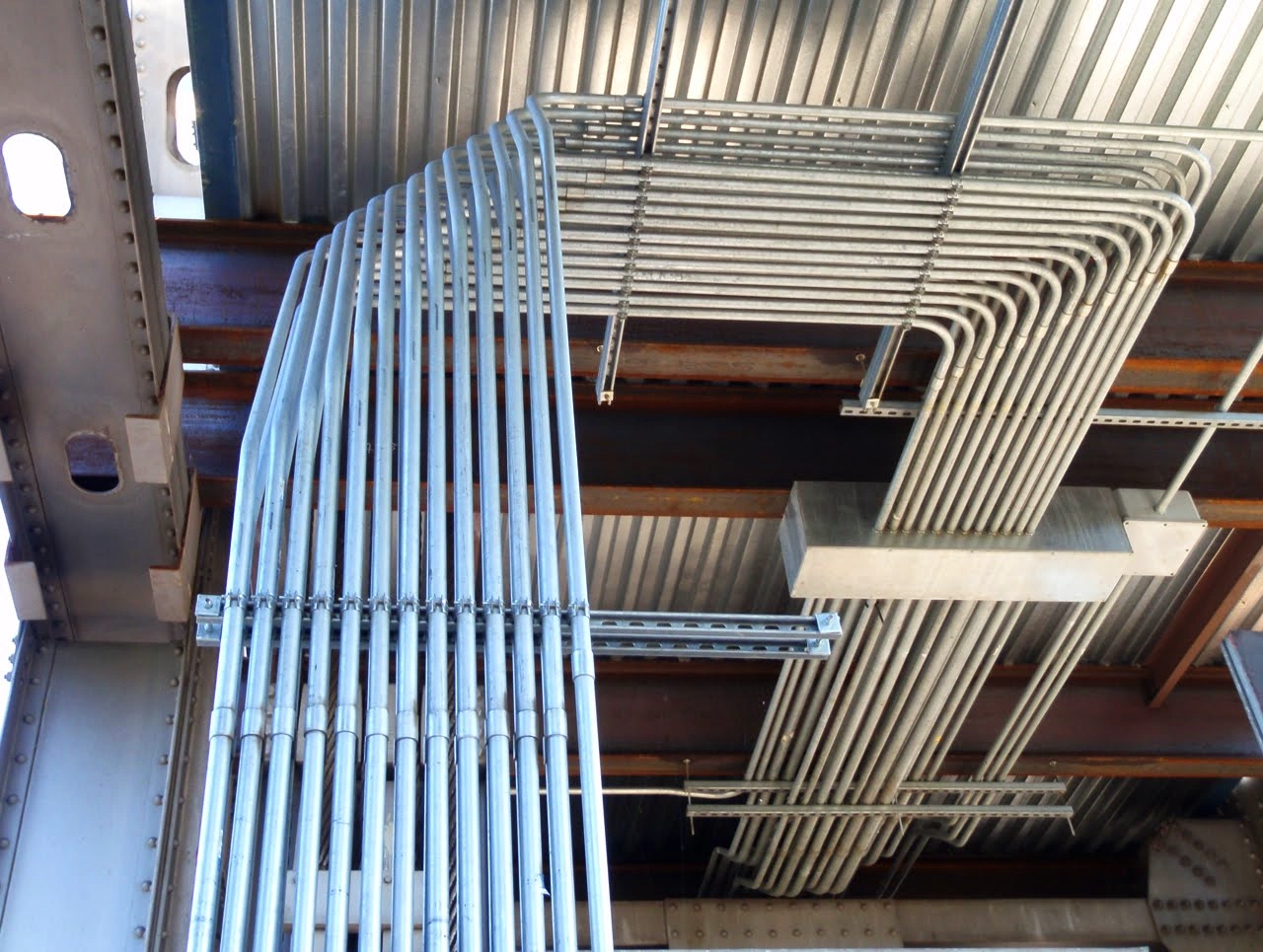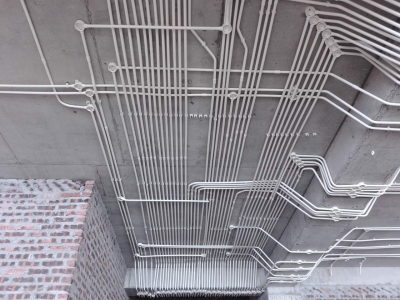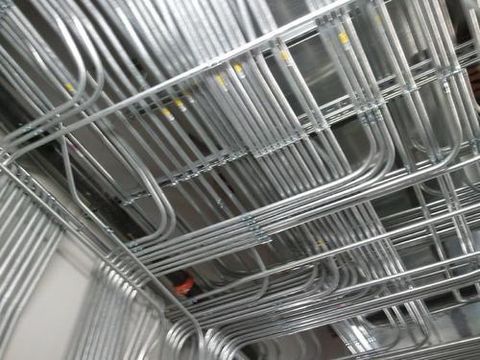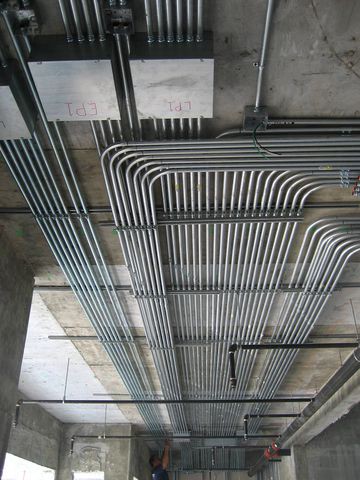For large buildings, the installation of rigid conduits is very important. The process of wiring the entire building requires a standard and durable electrical conduit, the usage and wiring method must also be scientific and for the right purpose. The use of conduit for electrical wires inside the wall or floating in the building will not only contribute to ensuring the safety of the wires being threaded inside but also increase the aesthetics of the building and the building.
Immediately refer to the following article of P69 Joint Stock Company about the regulations when installing the conduit, as well as the instructions for installing the rigid conduit.
Why install rigid conduit?
Installing rigid conduit is not too strange in our lives because they have the following outstanding features and benefits:
- This type of pipe has the main function of protecting family members, preventing you from direct contact with the electrical wiring under normal conditions and even when there is an electrical problem: short circuit, electric leakage. … thanks to the safe insulating plastic material.
- Protect the electrical system from contact, strong impact, attack from insects, targets or family pets, etc.
- Electrical insulation is safe and effective water insulator even in humid and dangerous environments.
- Increase the aesthetics of the home, rooms and wiring, and at the same time give us a sense of security when looking at the whole house.
- Saves you money in the event of a replacement or repair of the power cord by extending the life and service life of the cord.

Instructions on how to install the most rigid conduit today:
You can choose between two ways to go through the conduit to suit your structure and needs, including:
- Go Floating Conduit
- Go through the wall conduit
Each way will have a different installation method and give its own results and benefits, so you need to refer carefully to choose the right one!
The correct and fastest way to go through the electrical conduit
Here are the correct, fastest ways to go through the conduit along with the disadvantages you can refer to
How to go for floating conduit:
This is the traditional way of wiring, most used today by:
- They are easy to install
- Can be installed and repaired after completing the whole house
- The price for this type of pipe is quite cheap
- Does not require a lot of complicated and complicated techniques
- Easy to replace or repair, can change the structure, the wiring is quick and convenient.
Disadvantages:
- High rate of human collision and contact with plastic pipes, reducing safety
- Regularly subjected to heat and force from external agents.
- Low aesthetic value
Process of installing floating plastic conduit:
- Select the appropriate tube type. For floating mounting, round or flat gen tubes should be preferred.
- Installing a complete electrical circuit for the entire house, ensuring that the electrical network still operates normally when there is electricity
- Shut off the entire electrical system in the house to proceed with the conduit.
- Lead the conduit to the end of the electrical cord from the source to the electrical equipment
- Fix pipes and wires so that the path is shortest and neatest.

How to go through wall conduit
Customers now have gradually switched to installing pipes and wires in wall form, also known as recessed form. Contrary to the characteristics of floating pipes, this type of plastic conduit has the following advantages:
- Increase the aesthetics of the whole room
- Minimize exposure to plastic pipes and wires for family members
Disadvantages:
- Difficult to install and repair
- The power line is fixed
- Wiring is only allowed while the wall is under construction. After the house is complete, you cannot adjust the structure
- Vulnerable to serious problems if a short circuit occurs without being prevented by an anti-shock, anti-leakage circuit.
- Construction cost is quite high
- Requires highly skilled installers
How to go through wall conduit (submersible):
First, you need to choose which type of plastic pipe is suitable. For this type of threading, we recommend using a perforated tube or a rigid conduit.
After determining the fixed position of the electrical outlet and switch, during the construction of the wall, you need to follow the steps to thread the electrical conduit into the wall as follows:
- Make a path diagram for the electric wire
- Disconnect the entire local electrical system for safety before touching relevant parts of the circuit.
- Dig a wall trench according to the available diagram
- Cut the wall according to the instructions of the diagram. Pay attention to the narrow width of the power line, the cross-section of the conduit that you need to go.
- Put the plastic pipe into the groove and fix it with zinc wire.
- Insert the power cord into the plastic conduit and insert the upper conduit.
- Use glue to fill the groove so that it is completely covered and beautiful.
Regulations on installation of electrical conduit
When performing electromechanical construction, especially the conduit system, it should be followed and installed according to the standards. To install conduit correctly, M&E M&E engineers need to understand 35 regulations on installation of electrical conduit According to Section 8 of TCVN 9208:2012 standard for industrial works as follows:
1. A rigid metal conduit system must be applied. To be able to protect cables in the production area, supplement the cable tray system.
2. The conduit system is fully installed before the cable is inserted into the conduit. For this purpose, in the conduit, a primer must be available to pull the cable into the conduit. This standard is not mandatory for conduit systems placed in precast concrete structures.
3. For conduit systems in precast concrete structures. Wires and cables can be pre-threaded before concrete is poured. But measures must be taken to protect the end of the pipe to prevent mortar or concrete from entering the pipe. At the same time protect the wire ends sticking out of the pipe mouth from being broken.
4. For conduit systems in precast concrete structures. Pipes or cables should not be subjected to mechanical stress arising during installation and placing of concrete.
5. Before pouring concrete over conduit, these pipes need to be fixed. So that thickness of concrete after setting encloses the conduit cross section. At any point not less than 15 mm.
6. Total cross-section of cables or wires in conduits placed in concrete. Do not exceed 40% of the cross-section of the conduit.
7. Rigid conduit gland must be firmly fixed with clamps or other approved method. After the distance is not more than 2 m for metal conduit. And no larger than 1 m with rigid PVC conduit.
8. Steel conduit and accessories if placed in a humid, corrosive atmosphere. It must be hot galvanized or painted with anti-rust and anti-corrosion materials.
9. Steel conduit for conduit continuous length must have threads at both ends of the pipe mouth.
10. Open pipe mouth must be equipped with a bushing or a flared pipe. In order not to damage the cable insulation. If the open end of the pipe is inside the cover trough. Then use the bushing, and if the open end protrudes, use the flared mouthpiece.
11. The number of conduit elbows on a conduit is limited. Such that the total number of angles in all pipe bends doesn’t exceed 4 right angles. When encountering obstacles, the radius of curvature of the pipe elbow can be widened to facilitate installation. The angle of the conduit elbow is not less than 90°. When bending pipes, do not reduce the inner diameter of the pipe.
12. Conduit of medium-voltage cables is easy to identify thanks to contrasting colors and warning signs.
13. Metal conduit ensures electrical continuity. Metal conduit must be grounded and connected to the nearest ground wire.
14. When installing pipes, it is necessary to take measures to prevent water ingress.

15. Before threading the cable, the inside of the conduit must be cleaned thoroughly. Primer wire must be used to pull the cable inside the tube. However, do not use grease or lubricating material when pulling the cable through the conduit. As this may damage the cable insulation.
16. On long pipelines at the narrowing stage, thermal expansion must be compensated by expansion joints.
17. When placing the conduit route, it is necessary to choose the location of the junction box and accessories for convenient access to repair.
18. Use only conduit and accessories with protective non-combustible materials:
– Power cable for alarm, fire fighting equipment, human evacuation equipment and elevators.
– Cables placed in flammable areas.
19. Pipes and electrical cables into the equipment are arranged with anti-liquid gaskets according to the pipes entering the equipment.
20. The gaskets of pipe fittings shall be resistant to the corrosive effects of the material in contact with them.
21. Plastic conduits for electrical conduit are placed in an area where there is no corrosive effect. May be rigid pipes with threadless fittings.
22. Polyethylene conduit recessed in brick or plaster walls in offices or similar areas. It shall be fixed so that the outside surface of the pipe is at least 15 mm deeper than the finished wall.
23. Threaded metal conduit joints have washers of conductive material with anti-corrosion effect. And there must be no harm to the insulation of the cable.
24. Outdoor conduit is PVC conduit for conduit or ‘tropicalized’ steel conduit.
25. The rigid conduit shall have a radius of curvature (corresponding to the inner bend) large enough for the cable in the conduit to be bent as specified in the table below, but in no case less than 2.5 times the outside diameter of the conduit. tube.
| Insulation | Layer | Outer Diameter (mm) | Minimum bend radius of the (calculated by the number of outer poles of the cable) |
| Multi-strand braided copper or aluminum core rubber or PVC insulation | Not armored | to 10 | 3 |
| over 10 and to 25 | 4 | ||
| Multi-strand braided copper or aluminum core rubber or PVC insulation | Not armored | over 25 | 6 |
| Armored | any | 6 | |
| Solid copper or aluminum core PVC insulation | Armored or not armored | any | 6 |
| Insulation with oiled paper | Lead | any | 6 |
| Insulation with inorganic substances | Any | any | 6 |
26. The drain hole of the unsealed conduit system is located at the lowest point where moisture condenses.
27. During construction, temporary openings in the conduit system shall be sealed or carefully covered to prevent the ingress of mold and foreign objects.
28. The mouth of the short pipe that penetrates the wall leading the cable into the house must be sealed with a material that is not combustible and does not damage the insulation of the cable.
29. Conduit racks are placed using available structural fixings.
30. Spare conduits must be located near the cable connection to the equipment to facilitate future cabling.
31. Cable junction boxes for buried electrical conduit routes may only be installed when there is a written agreement from the engineer in charge of electrical construction supervision of the investor.
32. Screws, bolts and accessories for fastening conduit must be approved by the engineer in charge of supervision and electrical construction of the investor before use. Do not use wood to fix the conduit and only use electric drills or pneumatic drills to drill holes for fixing wires.
33. Construction of the pipeline can only be started when the location of the pipeline can be determined based on the drawing of the design consultancy agency.
34. When cutting conduit, it is necessary to cut it at right angles to the axis of the conduit.
35. Prior to installation, pipes and fittings must undergo inspection to ensure that they are free from electrical and mechanical defects:
– Visual inspection of strength, solidity, quality of welds and joints, coating, galvanizing, etc.
– Check for continuity and electricity of steel conduit.
Installation process of rigid conduit conduit

Step 1: First of all, it is necessary to give a wiring diagram to have a reasonable installation plan of rigid conduit. In this step we need to define the paths from the main power sources to the electrical boxes.
Step 2: Calculate the amount of pvc conduit that you will need. Based on the size of the electrical system to give the required number of conduit to use. For locations where the pipe needs to be shortened, we use a hacksaw to cut the pvc conduit.
Step 3: Proceed to bend the conduit to thread the wires in the necessary positions according to the positions that you have marked on the pipes in the previous steps.
Step 4: Use more plastic pipe accessories to connect, split or fix the pvc conduit into the wall.
Step 5: After installing the pipeline, we will proceed to thread and pull the electrical wires through the entire conduit route that you have installed.
Contact information P69 – M&E Contractor
Headquarter: No. 6/165C Xuan Thuy, Cau Giay District, Hanoi
Website: https://p69.com.vn/
Hotline: 02422121212 – 0965937799
Email: kd@cokhip69.com.vn
Facebook: https://www.facebook.com/p69nhathaucodien
LinkedIn: https://www.linkedin.com/in/congtyp69/
Youtube: https://www.youtube.com/channel/UCOUwCnE5iGj8iqe_ZIUM7oA

